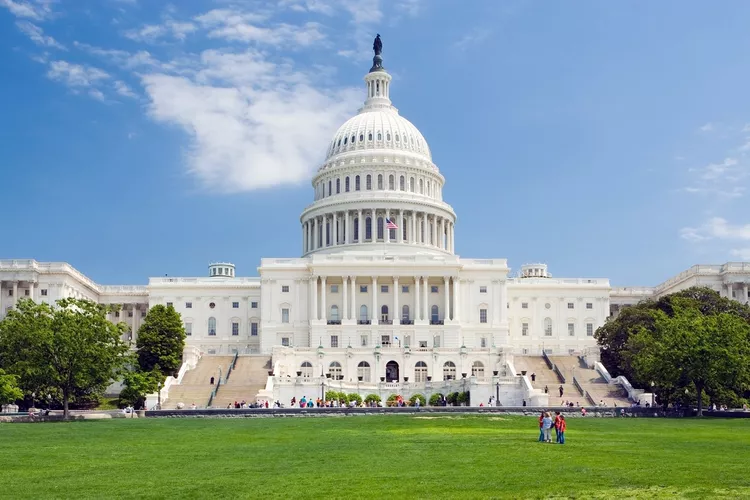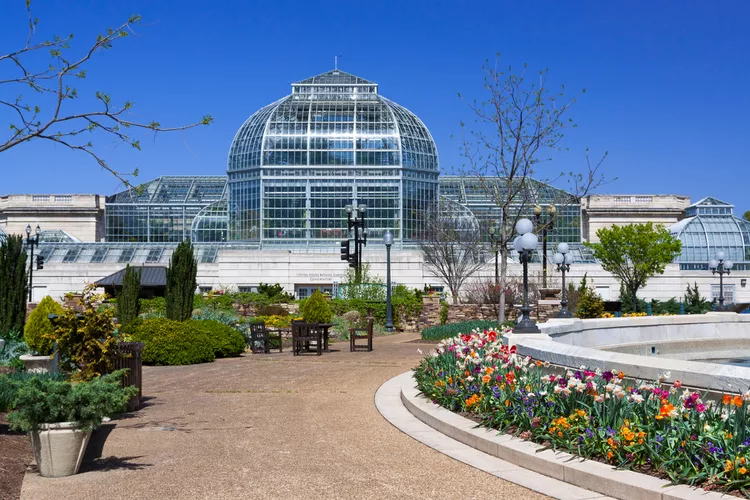Washington, D.C. is so much more than the political epicenter of the U.S. History buffs will love stepping back in time at the National Mall, and anyone with a passion for reading will swoon at the book collection in the Library of Congress. Nature lovers should opt for a springtime visit, when the cherry blossoms bloom and events start to trickle outside, including the Blossom Kite Festival. And let’s not forget that the country’s capital is also a college town, with universities like Georgetown, Howard, George Washington, and American all within city limits.
Whether you’re headed there to learn, play, or even just as a stopover before your next destination, you should explore everything the capital city has to offer.
The best time to go to Washington, D.C. is between April and June, when temperatures are moderately warm and events abundant.
How to Get There
You can get to Washington, D.C. by plane, train, and bus. Washington Dulles International Airport is the largest airport in the area and is serviced by all major U.S. airlines. However, it is located about 26 miles outside of D.C. in Chantilly, Virginia. Ronald Reagan Washington National Airport is only about five miles from D.C., but has significantly less flight options, as it is only served by eight airlines.
Amtrak trains have daily routes from major cities like New York, Boston, and Chicago that run directly to Union Station, which is within walking distance of some of D.C.’s most popular landmarks.
If you prefer the bus, companies like MegaBus offer several different routes to the capital city. MegaBus currently offers trips to D.C. from most major cities, including New York, Pittsburgh, and Boston.
Best Hotels
Riggs Washington, D.C.
The Jefferson
Rosewood Washington, D.C.
The Hay-Adams
Pendry Washington, D.C. The Wharf

Things to Do
Library of Congress
The Library of Congress is the largest library in the world, and the building itself is a work of art, with a beautiful, intricate reading room and other fine architectural details. It provides a great respite for anyone seeking knowledge or just a break from the D.C. humidity. Kevin Fanning, former D.C. tour guide and current regional sales manager at tour company WeVenture, recommends that travelers get themselves a library card. The library is closed on Sundays and Mondays, and all visitors must reserve a timed-entry pass before visiting. You can reserve them for free online.
George Washington’s Mount Vernon
Tour George Washington’s estate home and learn about the first president’s life and legacy at this historic site. In addition to the mansion, which offers timed entry, Mount Vernon has a museum and education center, gardens, a slave memorial, a working farm, and Washington’s tomb. There are also seasonal events here as well, including whiskey tastings, a colonial market, and fireworks. The estate is open 365 days a year from 9 a.m. to 5 p.m. Admission is $28 for adults, $15 for children between six and eleven, and free for children under five.
National Mall
Often referred to as “America’s front yard,” the National Mall is home to iconic monuments like the Lincoln Memorial, the Washington Monument, and the Martin Luther King, Jr. Memorial.
Museums
Washington, D.C. is home to 74 museums that cover topics ranging from history and art to science and aerospace. Notable museums include the National Museum of African American History and Culture; the Smithsonian National Museum of Natural History; and the United States Holocaust Memorial Museum, dedicated to the ongoing preservation of Holocaust history. Carolyn Crouch, founder of popular D.C. walking tour company Washington Walks, also recommends visiting the Capital Jewish Museum.

United States Botanic Garden
While the National Arboretum is larger in scale, don’t pass up the opportunity to see this curated nature exhibition right in the heart of downtown D.C. Established in 1820, this is the oldest continuously operated public garden in the U.S. — and a great place to escape the city and learn about various plants and flowers.
How to Get Around
Trains: The city’s Metrorail, run by Washington Metropolitan Area Transit Authority (WMATA), operates across Washington, D.C. and into parts of Virginia and Maryland. It has six lines — yellow, orange, red, blue, green, and silver. Metrorail rides cost anywhere between $2 and $6, depending on where you’re traveling and when. You can also buy a one-day pass for $13, a three-day pass for $28, and a seven-day pass for $58.
Buses: The city’s Metrobus system, also run by WMATA, will change drastically in the coming years for the very first time since the network’s creation in 1973. WMATA has created Better Bus, an initiative meant to completely revitalize the bus system. Changes will include the integration of new bus lanes, new transit signals, and better service times and locations that reflect the needs of D.C. residents. The project is still in its planning stage, but changes are set to roll out in 2024.
Taxis and Car Service: Uber and Lyft are available in the greater Washington, D.C. area, and there are taxi stands spread out across the city. To schedule a cab in advance, book through a local company like D.C. Yellow Cab. You can also schedule a local black car through services like ExecuCar.
Cars: Driving in the capital city isn’t necessary because the public transportation system is so comprehensive, but you can download apps like SpotHero to find and reserve parking spaces all across the city if necessary.

